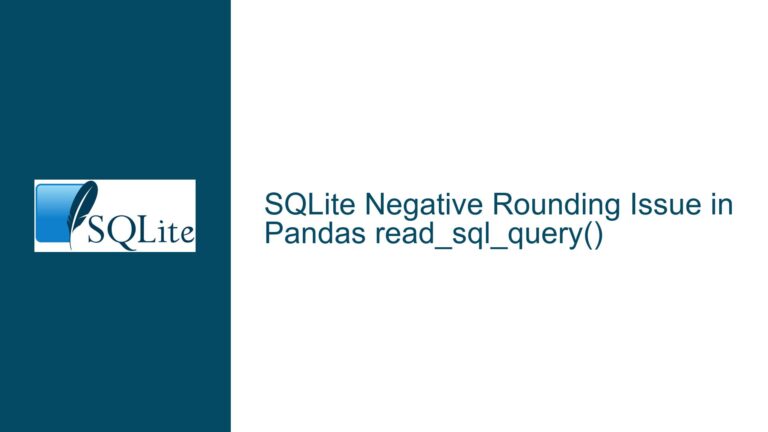Selecting Columns by Position or Dynamic Names in SQLite: Key Considerations and Solutions
Understanding Row Identifiers vs. Column Positions in SQLite
The core issue revolves around two distinct but related misunderstandings:
- Confusing row identifiers (e.g.,
ROWID,_ROWID_, or declaredINTEGER PRIMARY KEYcolumns) with column ordinal positions (e.g., "the 4th column"). - Attempting to reference columns dynamically using variables or ordinal positions in SQL queries.
SQLite operates under strict schema-based rules where column names and table structures must be known at query preparation time. Unlike spreadsheet tools, it does not natively support selecting columns by their numeric position or substituting column names via variables in standard SQL syntax. This limitation stems from SQLite’s design philosophy emphasizing stability, performance, and adherence to SQL standards while maintaining lightweight operation.
RowID Mechanics
Every SQLite table (except WITHOUT ROWID tables) has an implicit 64-bit signed integer ROWID that uniquely identifies each row. This value can be explicitly accessed using:
ROWID_ROWID_OID(legacy alias)
When a column is declared as INTEGER PRIMARY KEY, it becomes an alias for the ROWID. This column will auto-increment unless explicitly assigned a value and cannot store non-integer values. For example:
CREATE TABLE employees (
emp_id INTEGER PRIMARY KEY, -- Alias for ROWID
name TEXT
);
In this case, emp_id and ROWID refer to the same value. Changes to the table structure (e.g., ALTER TABLE) will not affect this relationship, making it safer for long-term data integrity compared to relying on implicit ROWID values.
Column Ordinal Position Risks
While applications can process query results by column index (e.g., sqlite3_column_text(stmt, 3) in C), this depends on the column order in the SELECT statement. Schema changes like adding/removing columns or altering CREATE TABLE statements will break such positional dependencies. For example:
-- Original schema
CREATE TABLE sensors (id INTEGER PRIMARY KEY, temp REAL, timestamp DATETIME);
-- Query expecting temperature at index 1:
SELECT * FROM sensors;
-- Schema altered by adding a column:
ALTER TABLE sensors ADD COLUMN location TEXT;
-- Now "temp" is at index 2; existing positional queries fail silently
Why Dynamic Column References Fail: Technical Limitations and Anti-Patterns
1. SQL Syntax Constraints
SQLite requires all identifiers (table names, column names) to be static during query preparation. Placeholders (?, :var) bind values, not identifiers. Attempting dynamic column references like:
SELECT :column_name FROM table; -- Invalid!
will parse :column_name as a string value, not a column identifier, returning literal strings instead of column data.
2. Column Order Instability
Relying on column positions is fragile because:
ALTER TABLE ADD COLUMNappends columns to the end.CREATE TABLE new_table AS SELECT ...reorders columns based on the select list.- Different SQLite versions might optimize column storage order (though rare).
3. Injection Vulnerabilities
Dynamically building SQL queries with string concatenation risks SQL injection if not properly sanitized. For example:
column_name = "salary; DROP TABLE employees; --"
query = f"SELECT {column_name} FROM employees;" -- Catastrophic!
4. Metadata Unavailability at Runtime
SQLite’s PRAGMA table_info(table_name) provides column metadata, but using this to dynamically resolve column positions requires additional application logic, complicating query execution.
Solutions: Schema Design, Safe Dynamic SQL, and API Practices
1. Explicit Column Aliasing for Row Identifiers
Always declare an INTEGER PRIMARY KEY column when needing stable row identifiers:
CREATE TABLE invoices (
invoice_id INTEGER PRIMARY KEY, -- Alias for ROWID
total REAL,
customer_id INTEGER
);
Use invoice_id instead of ROWID for CRUD operations to ensure stability across vacuum operations and table rebuilds.
2. Dynamic Query Construction with Sanitization
When column names must be dynamic (e.g., user-selected filters), sanitize identifiers using an allowlist or schema validation:
Python Example:
allowed_columns = {"name", "salary", "department"}
user_input = "salary"
if user_input not in allowed_columns:
raise ValueError("Invalid column")
query = f"SELECT {user_input} FROM employees;"
Using SQLite’s quote_identifier Function (C API):
const char *column_name = "sensitive; DROP TABLE users;";
char *safe_column = sqlite3_mprintf("\"%w\"", column_name);
char *query = sqlite3_mprintf("SELECT %s FROM users;", safe_column);
sqlite3_free(safe_column);
3. Column Index Resolution via Application Code
Process results using column names instead of indexes:
import sqlite3
conn = sqlite3.connect("company.db")
conn.row_factory = sqlite3.Row # Enable row["column_name"] access
cursor = conn.cursor()
cursor.execute("SELECT * FROM employees")
for row in cursor:
print(row["name"], row["salary"]) # Safe despite schema changes
4. Schema Versioning and Migration Safety
Use PRAGMA user_version to track schema versions. When altering tables, update queries accordingly:
PRAGMA user_version = 2; -- Schema version
-- Migration script for version 2:
ALTER TABLE employees ADD COLUMN birthdate TEXT;
5. WITHOUT ROWID Table Considerations
For tables declared WITHOUT ROWID, the ROWID alias is unavailable. Use explicit primary keys:
CREATE TABLE asset_registry (
asset_id TEXT PRIMARY KEY,
location TEXT
) WITHOUT ROWID;
6. Leveraging JSON Extension for Flexible Column Access
SQLite’s JSON1 extension allows pseudo-dynamic column access via JSON paths:
SELECT json_extract(data, '$.' || :json_path) FROM reports;
Store semi-structured data in a TEXT column with JSON contents, enabling flexible querying without schema modifications.
7. Prepared Statement Caching
Reuse prepared statements for common column access patterns to avoid re-parsing overhead:
// C API example
sqlite3_stmt *stmt;
sqlite3_prepare_v2(db, "SELECT name, salary FROM employees WHERE id = ?", -1, &stmt, NULL);
// Reuse 'stmt' across multiple queries with different IDs
sqlite3_bind_int(stmt, 1, 1001);
sqlite3_step(stmt);
8. ORM and Abstraction Layer Best Practices
If using an ORM (e.g., SQLAlchemy, Peewee), ensure it:
- Validates column names against schema metadata.
- Uses parameter binding for values.
- Avoids raw SQL string interpolation.
By adhering to these principles, developers can avoid the pitfalls of column position reliance and unsafe dynamic SQL while leveraging SQLite’s strengths in embedded environments and rapid prototyping.





